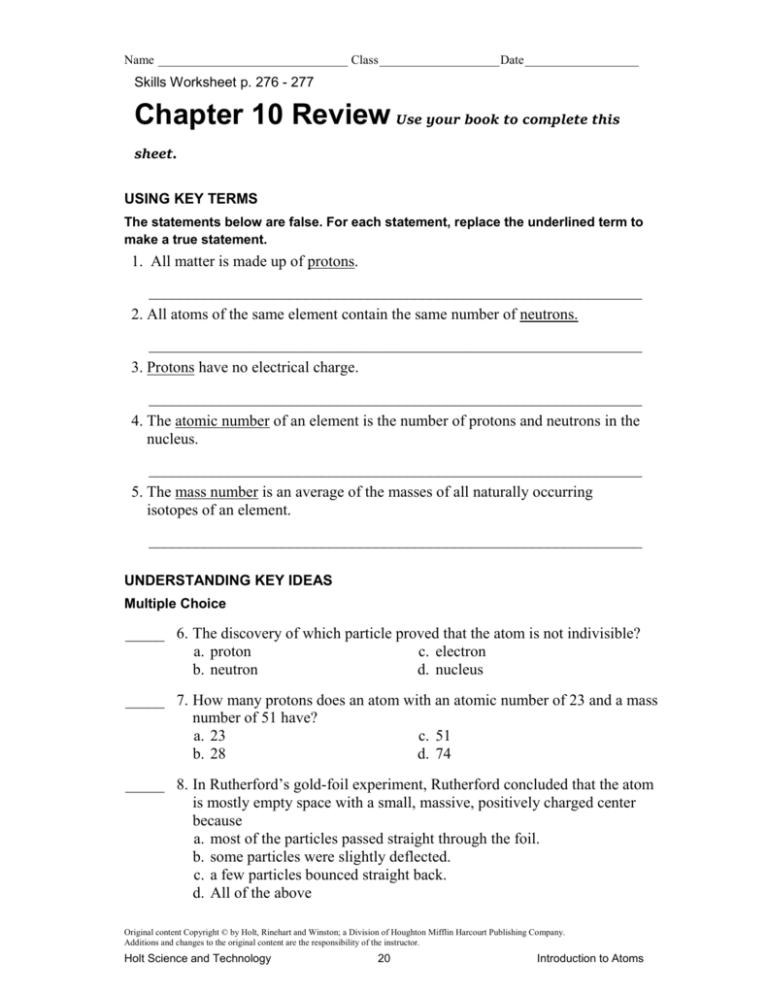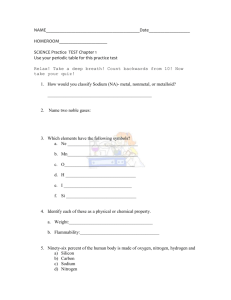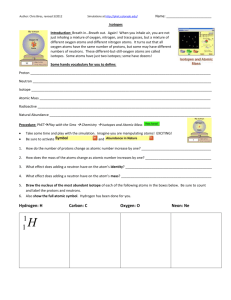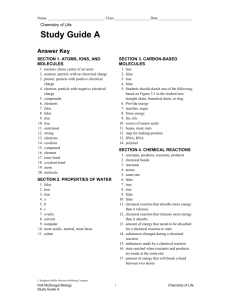Chapter 10 Review - nemsgoldeneagles
advertisement

Name ______________________________ Class ___________________ Date __________________ Skills Worksheet p. 276 - 277 Chapter 10 Review Use your book to complete this sheet. USING KEY TERMS The statements below are false. For each statement, replace the underlined term to make a true statement. 1. All matter is made up of protons. _______________________________________________________________ 2. All atoms of the same element contain the same number of neutrons. _______________________________________________________________ 3. Protons have no electrical charge. _______________________________________________________________ 4. The atomic number of an element is the number of protons and neutrons in the nucleus. _______________________________________________________________ 5. The mass number is an average of the masses of all naturally occurring isotopes of an element. _______________________________________________________________ UNDERSTANDING KEY IDEAS Multiple Choice _____ 6. The discovery of which particle proved that the atom is not indivisible? a. proton c. electron b. neutron d. nucleus _____ 7. How many protons does an atom with an atomic number of 23 and a mass number of 51 have? a. 23 c. 51 b. 28 d. 74 _____ 8. In Rutherford’s gold-foil experiment, Rutherford concluded that the atom is mostly empty space with a small, massive, positively charged center because a. most of the particles passed straight through the foil. b. some particles were slightly deflected. c. a few particles bounced straight back. d. All of the above Original content Copyright © by Holt, Rinehart and Winston; a Division of Houghton Mifflin Harcourt Publishing Company. Additions and changes to the original content are the responsibility of the instructor. Holt Science and Technology 20 Introduction to Atoms Name ______________________________ Class ___________________ Date __________________ Chapter Review continued _____ 9. Which of the following determines the identity of an element? a. atomic number b. mass number c. atomic mass d. overall charge _____ 10. Isotopes exist because atoms of the same element can have different numbers of a. protons. c. electrons. b. neutrons. d. None of the above Short Answer 11. Would there be a stronger gravitational force acting on the particles inside a hydrogen nucleus or the particles inside a uranium nucleus? Explain. _______________________________________________________________ _______________________________________________________________ 12. In two or three sentences, describe Thomson’s plum-pudding model of the atom. _______________________________________________________________ _______________________________________________________________ _______________________________________________________________ Math Skills 13. Calculate the atomic mass of gallium, which consists of 60% gallium-69 and 40% gallium-71. Show your work below. 14. Calculate the number of protons, neutrons, and electrons in an atom of zirconium-90 that has no overall charge and an atomic number of 40. Show your work below. Original content Copyright © by Holt, Rinehart and Winston; a Division of Houghton Mifflin Harcourt Publishing Company. Additions and changes to the original content are the responsibility of the instructor. Holt Science and Technology 21 Introduction to Atoms Name ______________________________ Class ___________________ Date __________________ Chapter Review continued CRITICAL THINKING 15. Concept Mapping Use the following terms to create a concept map: atom, nucleus, protons, neutrons, electrons, isotopes, atomic number, and mass number. Original content Copyright © by Holt, Rinehart and Winston; a Division of Houghton Mifflin Harcourt Publishing Company. Additions and changes to the original content are the responsibility of the instructor. Holt Science and Technology 22 Introduction to Atoms Name ______________________________ Class ___________________ Date __________________ Chapter Review continued 16. Analyzing Processes Particle accelerators are devices that speed up charged particles in order to smash them together. Scientists use these devices to modify atoms. How can scientists determine whether the atoms formed are a new element or a new isotope of a known element? _______________________________________________________________ _______________________________________________________________ _______________________________________________________________ _______________________________________________________________ 17. Analyzing Ideas John Dalton made a number of statements about atoms that are now known to be incorrect. Why do you think his atomic theory is still found in science textbooks? _______________________________________________________________ _______________________________________________________________ _______________________________________________________________ _______________________________________________________________ 18. Analyzing Methods If scientists had tried to repeat Thomson’s experiment and found that they could not, would Thomson’s conclusion still have been valid? Explain your answer. _______________________________________________________________ _______________________________________________________________ _______________________________________________________________ _______________________________________________________________ Original content Copyright © by Holt, Rinehart and Winston; a Division of Houghton Mifflin Harcourt Publishing Company. Additions and changes to the original content are the responsibility of the instructor. Holt Science and Technology 23 Introduction to Atoms Name ______________________________ Class ___________________ Date __________________ Chapter Review continued INTERPRETING GRAPHICS Use the diagrams below to answer the questions that follow. 19. Which diagrams represent isotopes of the same element? _______________________________________________________________ _______________________________________________________________ 20. What is the atomic number for A? _______________________________________________________________ _______________________________________________________________ 21. What is the mass number for B? _______________________________________________________________ _______________________________________________________________ Original content Copyright © by Holt, Rinehart and Winston; a Division of Houghton Mifflin Harcourt Publishing Company. Additions and changes to the original content are the responsibility of the instructor. Holt Science and Technology 24 Introduction to Atoms








